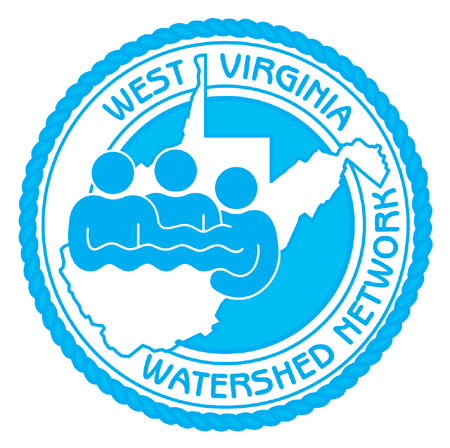 | | | | New Insights from Stream Monitoring in the Greenbrier River Watershed |
| By Than Hitt, Senior Scientist for West Virginia Rivers Coalition |
| 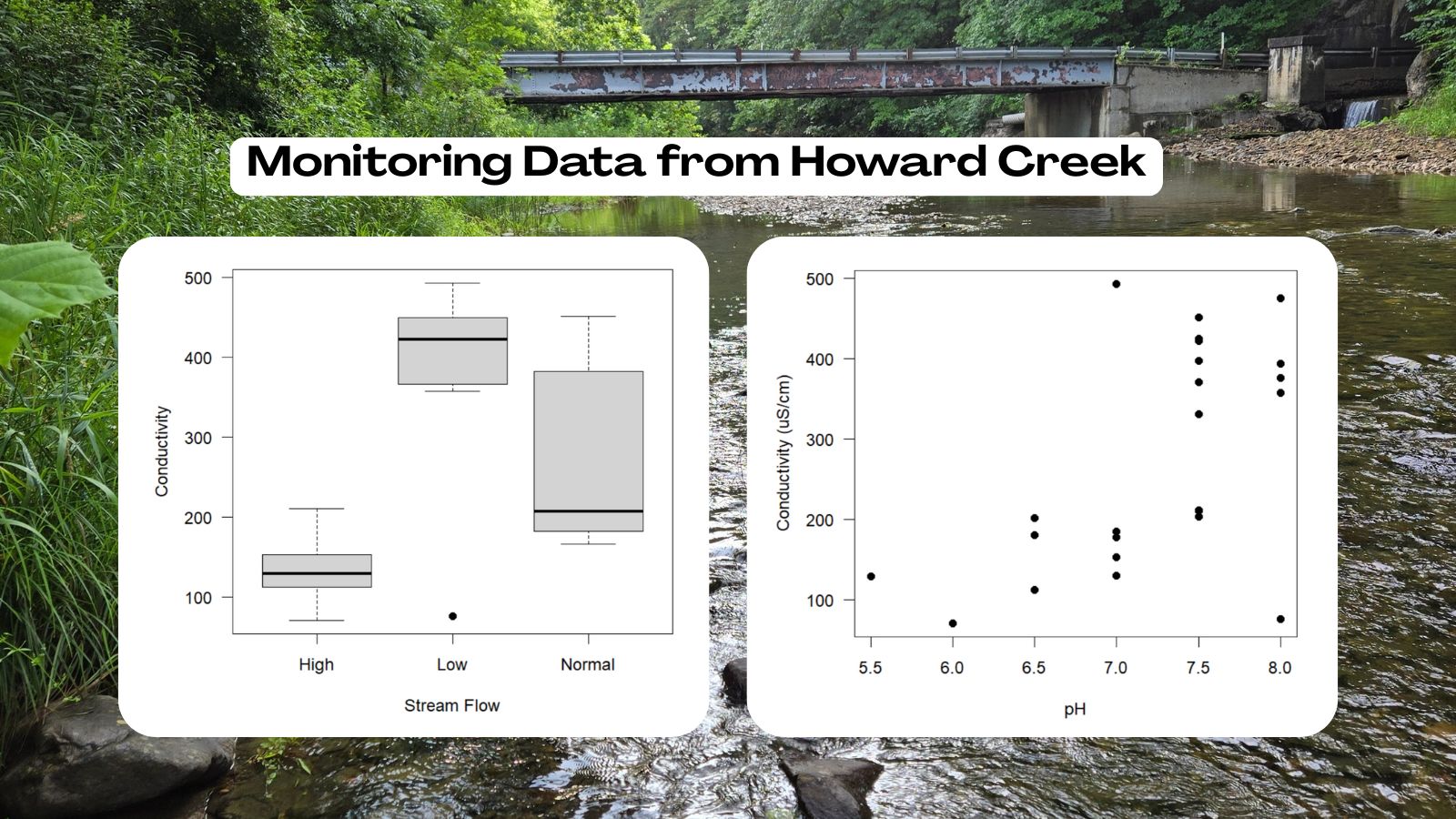 | Volunteer monitoring data collected from the Howard Creek sampling site in Greenbrier County, thanks to Elizabeth Clark, shows the effect of stream flow on conductivity (left) and the relationship between conductivity and pH (right). |
| Thanks to diligent surveys by Elizabeth Clark, we’re learning more about conditions in Howard Creek – a large tributary coming into the Greenbrier River near Lewisburg. Elizabeth has conducted over 25 surveys from May 2023 to June 2025, including measures of water quality and physical habitat. One important aspect of this includes measuring stream conductivity, an index of the amount of dissolved materials in water, because this can indicate the presence of mining pollution (sulfates) or urbanization (chlorides from road salts). However, it also requires that we understand natural variation in background conditions – particularly in places like the Howard Creek watershed that contain karst features and may naturally support significant loads of dissolved material due to the weathering of limestone rock. For instance, Elizabeth’s surveys reveal an important effect of dilution on conductivity (see figure): rainfall that causes higher flows has less dissolved material than baseflows, and therefore low stream flows have much higher conductivity values than higher flows. We also see this effect in pH such that higher conductivity values are associated with more alkalinity (higher pH) under low flow conditions. This is because calcium carbonate in limestone increases alkalinity when dissolved in stream water. In contrast, mildly acidic conditions were observed (pH < 7) during several surveys during higher flow conditions. That is because rainfall naturally is slightly acidic and therefore can counteract alkaline conditions to some extent. This is a particularly important finding as we consider natural variation in conductivity to interpret ionic toxicity pollution limits in the lower Guyandotte River and elsewhere. For example, EPA has determined that conductivity values greater than 300 uS/cm cause biological impairments in streams for regions outside karst. The new survey results from Howard Creek demonstrate the importance of considering rainfall and streamflow in this regard. Looking ahead: a new monitoring team has come together to survey Milligan Creek – an excellent trout stream in the Greenbrier River watershed – and the Howard Creek results can provide an important comparison. Stay tuned! |
| |
|
|
|
| Farewell - Changes to the Stream Partner AmeriCorps VISTA Team. Thank you, Kate! By Jessica Bryzek, Northern Basin AmeriCorps VISTA for West Virginia Department of Environmental Protection |
| 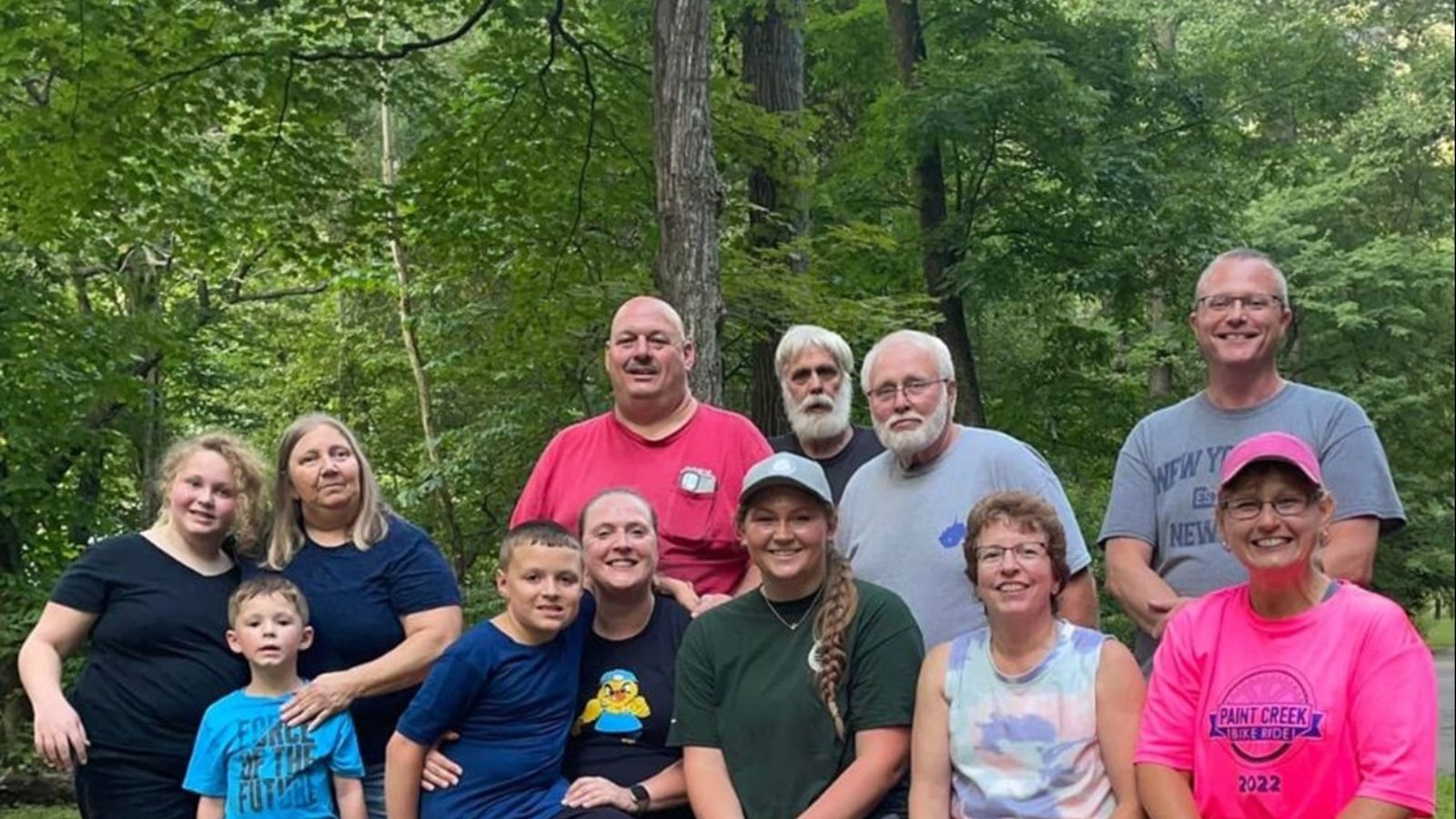 | Kate (center) and the folks at Paint Creek Watershed Association. |
| 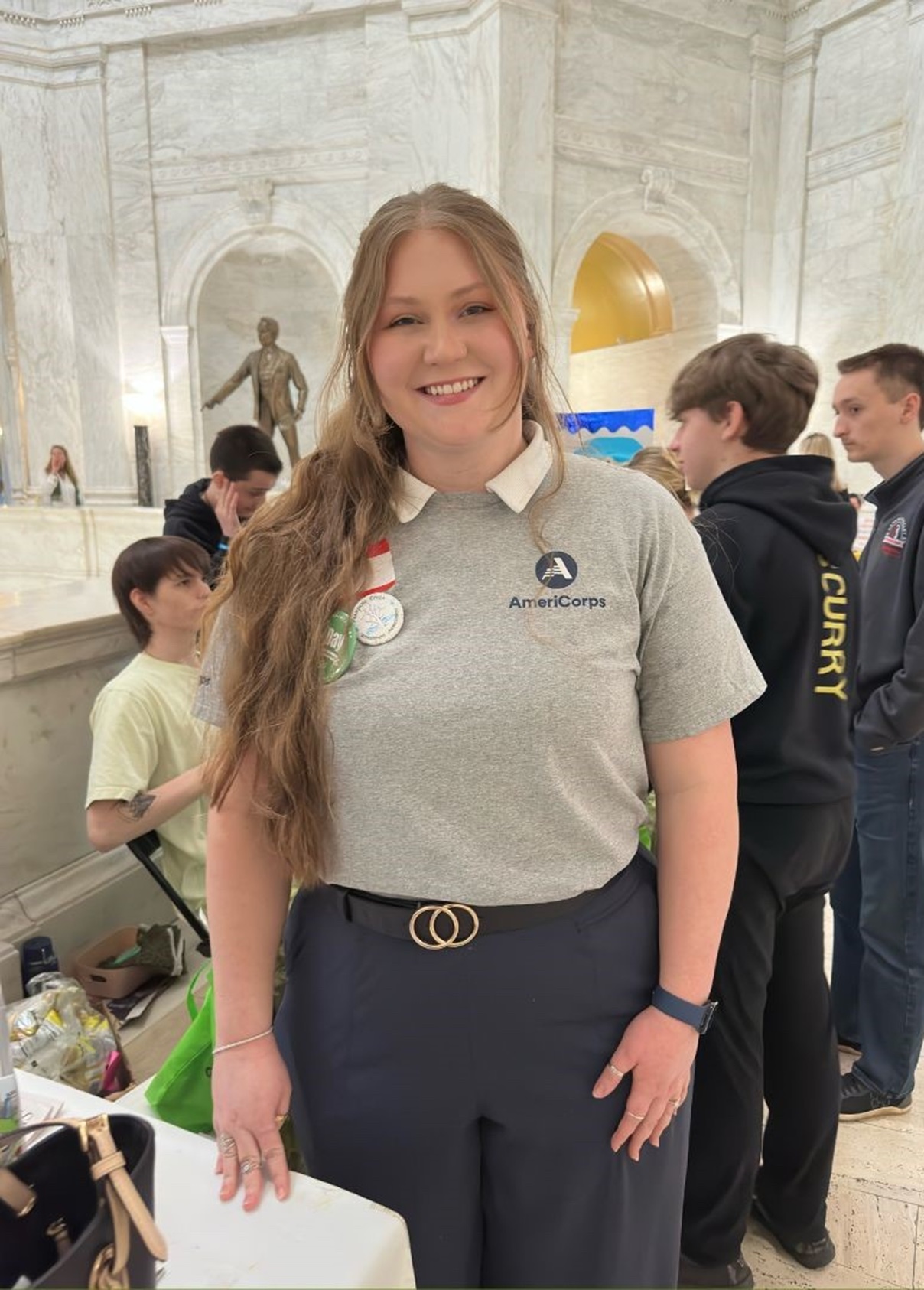 | Kate Cruickshank at the WV State Capitol for an advocacy day. |
|
|
Kate Cruickshank has finished her two years of AmeriCorps VISTA service. A WV native from Sissionville, Kate has endless passion for the state’s rivers and people who work to protect them. During her two years of service, Kate provided capacity-building services to three watershed groups across multiple projects. With Paint Creek Watershed Association, Kate helped plan and find funding for a pollinator garden adjacent to their fishing pier. She also assisted Twelvepole Rising with planning and developing the Twelvepole Creek Water Trail, a proposed 12-mile route in Wayne County. With Fourpole Creek Watershed Association, she helped plan a Dog Park Infiltration Trench that will help collect water runoff. In addition, Kate organized monthly walking and paddling events, as well as assisted with outreach, education, and community clean-up events. Kate developed personally and professionally along the way — and we are grateful for her service to our watershed. Most notably, Kate acknowledges that she learned how to be more flexible and adaptable during the project management lifecycle, from idea to creation — a good reminder for everyone working within our watershed community. |
|
|
| | Meet Mary, WVDEP's New Potomac Basin Coordinator! |
| An introduction from Mary DeWees, Potomac Basin Coordinator for West Virginia Department of Environmental Protection |
| Hi everyone! My name is Mary DeWees, and I’m excited to be the new Potomac Basin Coordinator for the West Virginia Department of Environmental Protection. For the past two years, I’ve worked in the Water Quality Standards and Assessment program in the Charleston office, and I’m thrilled to now be focusing on watershed efforts in a region that means so much to me. I grew up in Charles Town, right along the Shenandoah River, so returning to this area truly feels like coming home. I graduated from Marshall University in 2021 with a degree in Biological Sciences. After college, I worked as a raft guide on the Shenandoah and Potomac rivers — a job that completely changed my career path. Guiding wasn’t just about getting people down the river safely; it was about sharing the beauty, ecology, and history of these waterways. |
|
|
| That experience inspired me to pursue a role in environmental protection and led me to the WVDEP. As Potomac Basin Coordinator, I’m here to support local watershed projects, help connect partners to funding opportunities, and assist with project implementation. I’m looking forward to working with communities throughout the basin to protect and improve our wonderful resources! |
| | Building Capacity, Cultivating Community: Meet a VISTA at Guardians of the West Fork An interview with Martin Christ and Hannah Blakely for West Virginia Department of Environmental Protection |
| At the intersection of environmental restoration and community resilience, Hannah Blakely is helping Guardians of the West Fork deepen their impact in north-central West Virginia. Hannah is applying her passion for conservation to support everything from volunteer coordination and youth programming to fundraising and regional collaboration. Through her work, she’s helping build lasting capacity for watershed health while strengthening connections between people and place. Please get to know Hannah in this short interview today! Which VISTA program do you come through?
I am an AmeriCorps Steward VISTA How did Guardians of the West Fork get their funding?
Through the Ohio River Valley Participatory Fund! (Check out ORVPF's open funding opportunity below!) |
|
|
| What are your tasks for the Guardians?
My tasks for Guardians of the West Fork are designed to strengthen organizational capacity, enhance watershed health, and deepen community engagement. It is all plan-based and begins with poverty alleviation through environmental and recreational projects by identifying community needs, prioritizing initiatives that improve access to nature, and promoting outdoor recreation and environmental education while maintaining consistent outreach through media and events. Fund development and grant writing efforts focus on researching and securing funding aligned with environmental goals and coordinating with partners to implement projects. Volunteer management includes creating clear roles, improving tracking systems, recruiting new volunteers and board members, and aligning tasks with individual strengths. Community engagement is fostered through events like Watershed Day, youth activities, and the expansion of the Watershed Champions program, alongside stakeholder presentations and the recruitment of a diverse Advisory Board. There is a large emphasis on organizational efficiency and regional collaboration by refining internal systems and building partnerships with neighboring watersheds to pursue shared initiatives. My work starts with foundational planning, moving into active implementation, and culminating in evaluation and sustainability efforts. Where are you from?
I am from Wheeling, WV Do you have a favorite river from home?
The Ohio River is my favorite river from home. What do you study?
I am studying Environmental Soil and Water Science with a minor in Agricultural Law at WVU. What are your plans for after your VISTA term?
Following my VISTA Term I plan to find a job related to environmental conservation with a long-term goal of working for the U.S. Environmental Protection Agency. Where is your office location?
My position is the majority remote, so my office is my desk at home! How did you find Guardians of the West Fork?
I found Guardians through a program at WVU called Common Waters! Common Waters aims to address community and student needs by providing innovative opportunities for student-community engagement around rural water issues. I was paired with Guardians and through my work with Common Waters I got my current Americorps position! Have you found a favorite place on the West Fork?
I would say that my favorite place on the West Fork is Lambert Run! |
|
|
| | Stories of WV Watershed Organization and Their People - Share YOUR Story! |
| 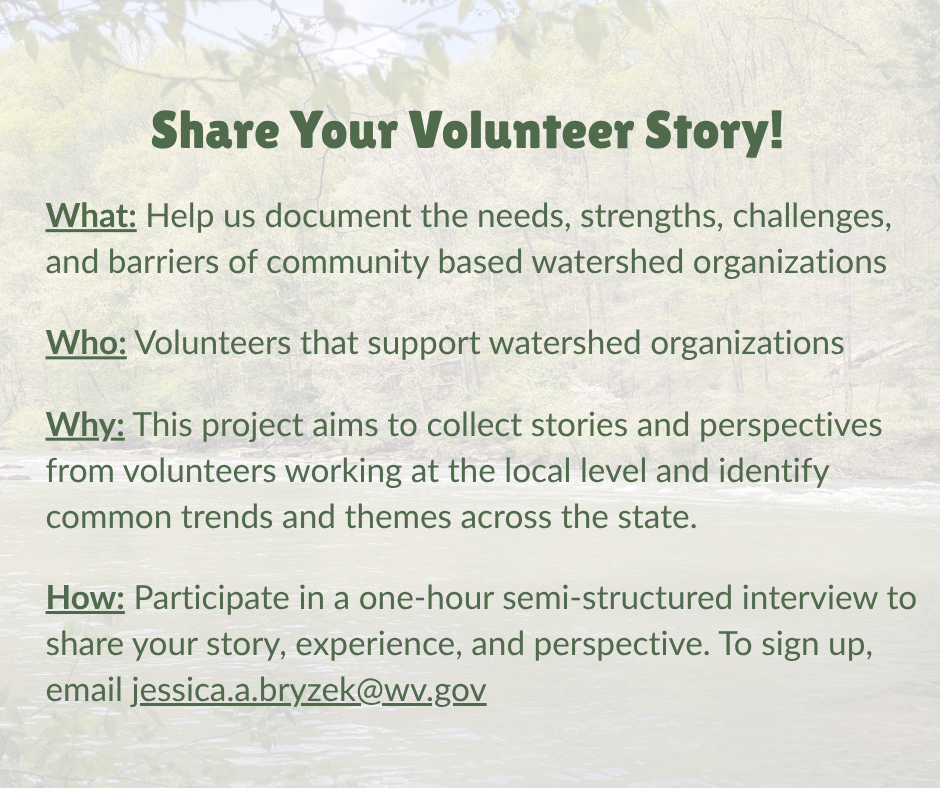 | We need your help! You are invited to participate in a state-wide project that documents the strengths, challenges/barriers, needs, and future opportunities for Community-Based Water Organizations (CBWO) and the volunteers who support them. CBWO are prevalent throughout West Virginia, and while some have been around for a long time, others have recently organized. This project aims to collect stories and perspectives from volunteers working at the local level to identify common trends and themes relevant to CBWO across the state. These organizations and their volunteers create invaluable opportunities for our local communities and waterways, and we hope this project will spark future discussion and solutions to provide additional support to these efforts. Participation in this project includes a one-hour semi-structured interview. If you are interested in participating, please email jessica.a.bryzek@wv.gov |
| |
|
| Save the Date for the 2025 Watershed Symposium By Lisa Maraffa, Program Assistant & Events Producer for Friends of the Cheat |
| The West Virginia Watershed Network (WVWN) is hosting the WV Watershed Symposium on Friday and Saturday, October 17th-18th, 2025, at Battlers Knob in Philippi, WV. The statewide watershed-focused event will take place from 9:00 a.m. to 5:00 p.m. on Saturday, featuring a full day of engaging presentations and discussions. Topics will include restoration projects, effective communication strategies, group marketing, legislative updates, and more. The event will also provide opportunities for networking, sharing updates from watershed groups, and celebrating accomplishments during an award ceremony. Tabling opportunities are available; please contact Lisa@cheat.org to arrange a spot.
On Friday, we invite you from 12:00 p.m. to 4:00 p.m. for a networking opportunity on the water. More below! REGISTRATION DEADLINE: Tuesday, September 2, 2025 |
|
|
| | FOR WATERSHED GROUPS TRAVEL SCHOLARSHIPS AVAILABLE ($50 Max): Through support from the WVDEP's Nonpoint Source Program, Natural Resources Conservation Service, the West Virginia Conservation Districts, the WVWN is able to offer watershed groups the opportunity to apply for a travel scholarship. The maximum amount for each travel scholarship is $50 per watershed group (not per watershed group member). Complete the fields in this form to submit an application for your watershed group to receive a travel scholarship, which can be used for gas or other travel expenses. Watershed group members will sign an invoice and then a check will be mailed to your group after you attend the event. LODGING: Lodging for watershed groups is available at no cost. Please select the room that works best for you in the lodging section below. Partnering agencies and all other attendees must arrange their own lodging by contacting Cheri Sturm at Battler's Knob - (304) 613-7180. If you have any questions, please reach out to your Basin Coordinator. We look forward to seeing you at the event! |
|
|
| | | | Nominate Local Watershed Champions to Win a 2025 WV Watershed Award! |
|  | Know a group of watershed stewards who ought to be recognized for their efforts? Nominate them today! |
| Our wild and wonderful state is home to many nonprofit watershed groups that dedicate their time and effort to protecting and restoring our water. At the 2025 West Virginia Watershed Network Symposium, five of these groups will be recognized for their outstanding work. -
Awards in the amount of $500 will be given based on your nominations, thanks to the ML/RD Justice & Peace Fund. -
Watershed groups may nominate themselves or others. Read the award descriptions below and fill out the nomination form by September 2, 2025, to participate! Honorees will be recognized at Battler's Knob on the weekend of October 17 and 18: -
The Headwater Hero Award - Recognizes a group that has successfully completed a recreational project in the past two years. -
The Stream Smarts Award - Recognizes a group that has successfully completed an education project in the last two years. -
The Watershed Guardian Award - Recognizes a group that has successfully completed an advocacy campaign in the past two years. -
The Restoration Rockstar Award - Recognizes a group that has successfully completed a restoration project in the last two years. -
The Rookie of the Year Award - Recognizes a new watershed group that is making things happen! This group is new and has successfully grown and implemented at least one new project in the past two years. Keep in mind that each group will only receive one award; we recommend varying your nominees! |
| |
|
| | Now Open: 2025 Grant Round for Watershed and Community-Based Groups Impacted by Fossil Fuels |
| 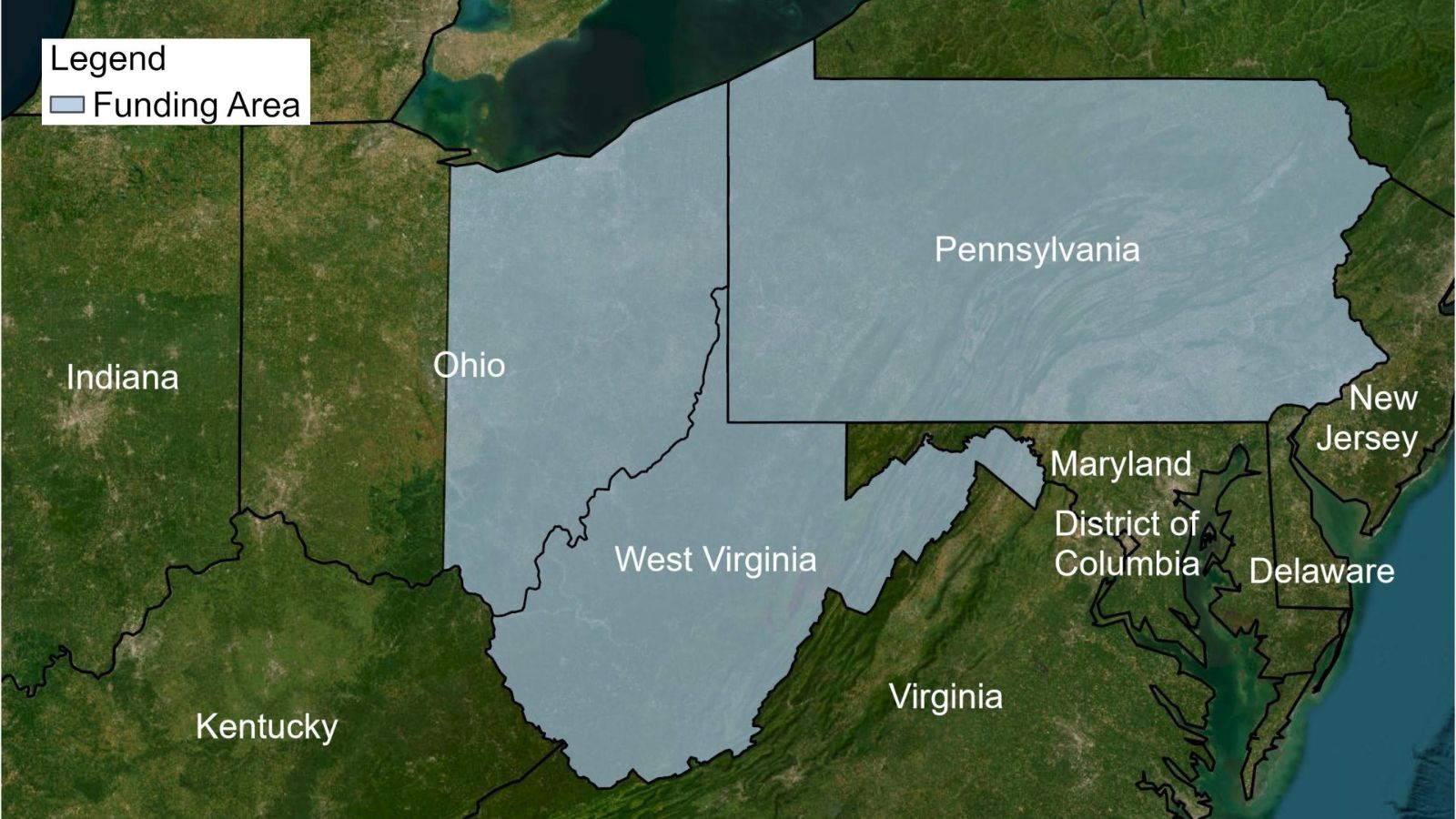 | Map of the funding area for the Ohio River Valley Participatory Fund which includes all of West Virginia, Pennsylvania, and part of Ohio. |
| WV Rivers is a steering committee member of the Ohio River Valley Participatory Fund (ORVPF), which provides grants to nonprofit groups that are helping impacted communities address environmental, health, democracy, justice, movement-building, and economic development goals in PA, WV, and Eastern Ohio communities that have been impacted by the fossil fuel industry. ORVPF is pleased to announce that we just opened our first 2025 grant round for general operating support grants, and watershed groups are eligible to apply. The RFP, which includes the application questions and instructions for applying, is also available via ORVPF website. Applications are due by Monday, July 28th at 11:59 p.m. If you or others would like to learn more or have questions, join our optional information session on Tuesday, July 22nd, 6-7 pm, please register here. If you have general questions about the Fund, about your organization’s eligibility, or if you need accommodations in order to apply (e.g., help via phone, translation services), please contact ORVPF@nonprofit-partners.org. If you need technical assistance with the grant application system, please contact Mark Keim at mkeim@nonprofit-partners.org. |
| | |
|
| Meet Our Latest Grantees + Apply by August 15 |
| 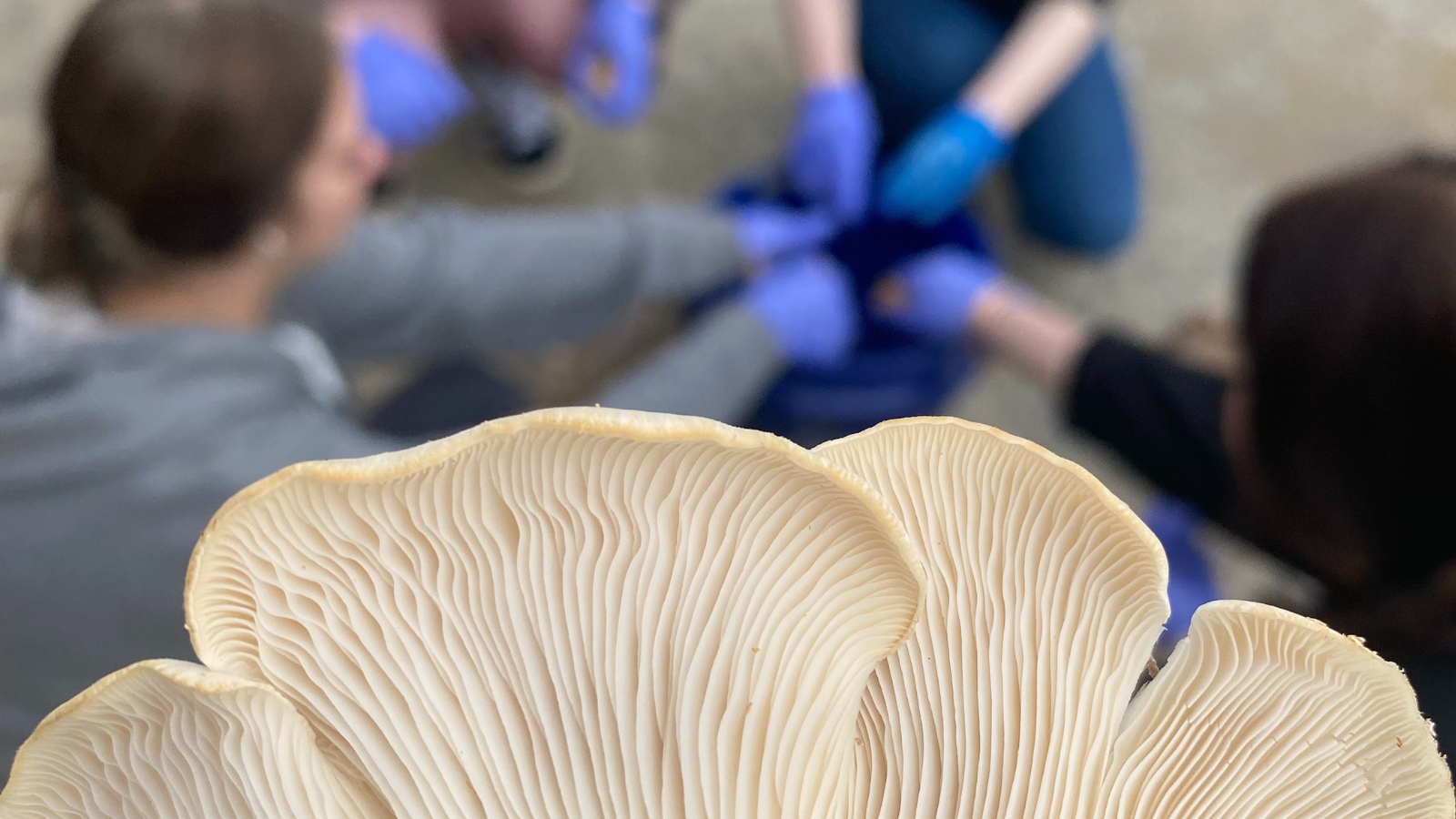 | | A white oyster mushroom and a group of students in Fayette County helping Plateau Action Network, one of our new mini-grant recipients, with their Fayette Co. Fungi Initiative. |
| Do you have a grassroots idea to protect water where you live? WV Rivers’ Community Action Mini-Grant Program is now accepting applications for the next round — due August 15! These ≤ $2,500 grants support local leaders and organizations advancing clean water, climate action, and environmental justice across West Virginia. We're proud to spotlight the good work funded in our most recent round: - Judy’s Garden Club (Braxton County) is hosting a rain barrel workshop to help residents reduce water bills, adapt to drought, and raise awareness for affordable water solutions.
- Midland Trail High School (Fayette County) is launching Trout in the Classroom with WV DNR and Trout Unlimited, engaging students in water quality science and stream stewardship.
- Tucker United (Tucker County) is organizing against industrial development, holding public meetings and installing signage to protect clean air and water.
- Plateau Action Network (Fayette County) is piloting a mycoremediation project, using mushrooms to naturally filter pollutants from tributaries flowing into the New River.
- Protect Middleway (Jefferson County) is tracking seasonal groundwater changes to build a data-driven case for long-term protection of the Lake Louisa/Turkey Run watershed.
Since 2019, WV Rivers has awarded over $78,000 to 46 grassroots projects — and we’re just getting started. Whether it’s clean water monitoring, community science, or environmental education, we want to help your ideas come to life. 🔗 Apply by August 15 or learn more about the program below. |
| | |
|
|
|
| | West Virginia Rivers Coalition
3501 MacCorkle Ave SE #129 | Charleston, West Virginia 25304
304-637-7201 | wvrivers@wvrivers.org |
| The WV WaterNet is made possible through an award of Environmental Protection Agency’s 319 funding awarded to the West Virginia Rivers Coalition by the West Virginia Department of Environmental Protection. |
|  | |
|
| |
|
|